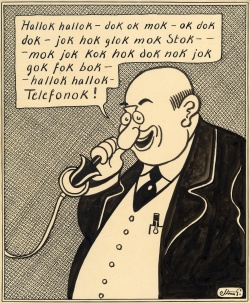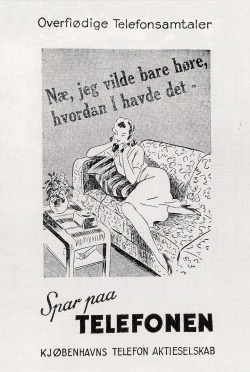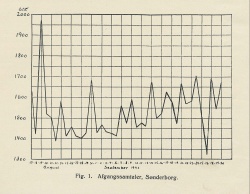Telephonenough!
01. Nov. 2004

In his humorous manner Storm P. depitcted the rationings and restrictions of the occupation. This drawing from 1943 is titled "That settlesit!".
We have to go back to the years of 1940-45 when Denmark was occupied by Germany, when mobile phones were still a dream of the future, and when the telephone market was divided between the Post & Telegraph Service (P & T) and six regional telephone companies.
The occupation caused no serious damages to phone installations and cables, but the fact that the country was cut off from international trade, not to mention the rationing system in general, also hit the telephone companies and P & T. The cutback in deliveries of copper for the telephone companies caused a delay in the automating of telephone centrals, and extension of the cable network was limited. At the same time telephony increased as never before. From 1941 to 1942 the Copenhagen telephone company KTAS registered an increase of the number of telephone calls of 8.7 % and 8.4 % the following year. Figures from the town of Sonderborg where P & T was in charge of the telephone service show an increase of more than 30 % between 1938 and 1942, and the largest increase actually took place after 9th April 1940.

Advertisement, printed in the newspaper Politiken in June 1943. The text reads:
Unnecessary Phone Calls
"What is your result of the calculation?"
Economize on the Telephone
Copenhagen Telephone Company Ltd.
People's need of communication during the occupation may partly be explained by the war being an extraordinary situation. Statistics of calls reached their peak during the days immediately after the outbreak of World War II on 1st September 1939 and were only exceeded on the occupation day 9th April 1940. Moreover, local records show a particularly high number of calls subsequent to certain incidents, e.g. an air battle over the island of Als on 18th August 1942. In autumn 1942 when German fortunes of war turned and the occupation began to assume another character, the number of calls reached unprecedented heights. The need for communication followed the development of the war closely. The more uncertain the political situation was, the greater the need of the population to communicate.

Advertisement, printed in the newspaper Politiken in June 1943. The text reads:
Unnecessary Phone Calls
"Well, I just wanted to hear how you were"
Economize on the telephone
Copenhagen Telephone Company Ltd.
Telephonenough!
To the telephone companies and P & T the significant increase in telephone calls as well as the services to the Germans meant nice profits. At the same time the burden of labour grew heavily, and the demand for new cables and automatic centrals increased. The demand simply exceeded the capacity of the telephone companies and P & T. In order to prevent a major breakdown and to maintain a certain standard, something had to be done to limit the number of telephone calls.
In 1943 KTAS therefore put a premium on the word telephonenough which was to be used during telephone conversations as an encouragement to the interlocutor to stop unnecessary talk. As in our days telephonenough was marketed in all accessible media. There is not much to say about the effect of the campaign, but at least it had public attention. As long as there were long waiting lists to get a telephone, i.e. until the 1950'ies, the word telephonenough was justified. Still there was a long way to mobile phones and "call as much as you like" and "talk as much as you like".

The graph shows the daily number of outgoing telephone calls at Sonderborg State Telephone during the period 17th August-30th September 1942. Note the extremities on 19th Aaugust, the day after an air battle over the island of Als, and on 26th September, the 70th birthday of King Christian the 10th.
The story of the word "telephonenough" emerged during the preparations for the exhibition about the history of communication during the period of occupation which the museum opened April 2005.
This article may be copied or quoted with MuseumsPosten, Post & Tele Museum as source.
Comment this article
Only serious and factual comments will be published.